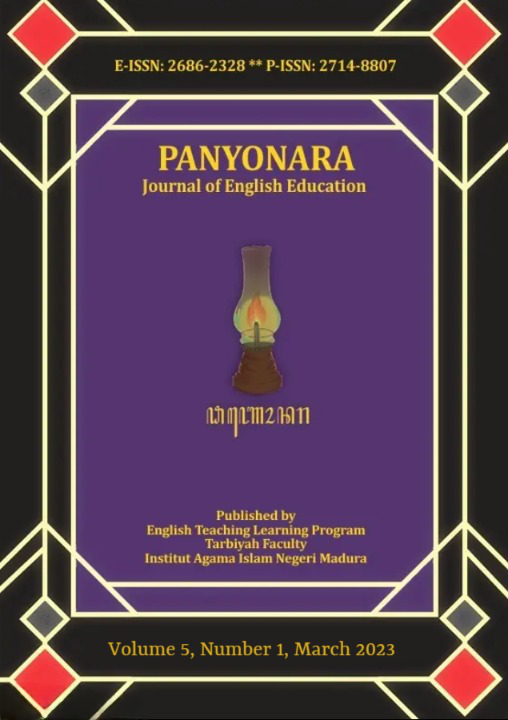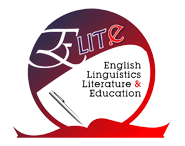Rhetorical Move Analysis on the University Students' Presentation: Move in the Oral and PowerPoint Slide Presentation
 Abstract views: 284
,
Abstract views: 284
,
 PDF downloads: 321
PDF downloads: 321
Abstract
There is a limited study view on rhetorical moves employed in both students’ oral presentations and PowerPoint slides in the classroom presentation. Few studies are largely realized on oral and slide movement in the conference and thesis presentation. Furthermore, the purpose of this research paper is to expose what are move employed by students in presenting classroom course project presentation orally and on slide, and what moves which is hampered in both. A qualitative survey based on the observation technique was used for data collection purposes. Data are analyzed using two divergent theoretical frameworks. The finding reveals students employ four moves of oral presentation; introduction, body, conclusion, and Q&A move. Otherwise, the Powerpoint slide highlights two moves including the body and conclusion move, the opening move seems optional. Further, orally, the omission of a summarization step in the conclusion move hampers students in reminded any point of the presentation thereby hampers the audience in strengthening their recall and understanding. The transition between spoken and written genres within the PowerPoint slide hampers through the dissipation move in both. Thus, the teacher should take into account the importance of rhetorical knowledge toward the presentation movement either in the oral or PowerPoint slides.
Downloads
References
Ackland, G. M. (2009). A Discourse Analysis of English and French Research Article Abstracts in Linguistics and Economics. San Diego, CA: Montezuma Publishing.
Ädel, A. (2023). Adopting a ‘Move’ Rather Than a ‘marker’ Approach to Metadiscourse: A Taxonomy for Spoken Student Presentations. English for Specific Purposes, 69, 4–18. https://doi.org/10.1016/j.esp.2022.09.001
Ali, S., & Corresponding, K. (2015). The Efficacy of Topic Familiarity on Oral Presentation: Extensive Speaking Assessment Task of Iranian EFL Learners in TBLT. 91-97(3). https://doi.org/10.7575/aiac.ijalel.v.4n.3p.93
Anthony, L., Orr, T., & Yamazaki, A. K. (2007). Signaling Transitions in Oral Presentations: Language and Strategies. IEEE International Professional Communication Conference, November. https://doi.org/10.1109/IPCC.2007.4464052
Berk, R. A. (2011). How to Create “Thriller” PowerPoints® in the Classroom! Innovative Higher Education, 37(2), 141–152. https://doi.org/10.1007/s10755-011-9192-x
Brook, G., & Wilson, J. (2014). Using Oral Presentations to Improve Students’ English Language Skills. Kwansei Gakuin University Humanities Review, 19, 199–212.
Chutamas, S., & Richard, K. (2009). The Oral Presentation as Context for Learning and Assessment. Innovation in Language Learning and Teaching. Innovation in Language Learning and Teaching, 4(2). https://doi.org/10.1080/17501220903125021
Cotos, E. (2018). Move Analysis. The Encyclopedia of Applied Linguistics, 1981, 1–8. https://doi.org/10.1002/9781405198431.wbeal1485
Degano, C. (2012). Texture Beyond the Text: Slides and Talk in Conference Presentations. Cerlis Series, 1, 135–152.
Douglas, B., Ulla, C., & Thomas, A. (2007). Discourse on the Move: Using Corpus Analysis to Describe Discourse Structure. John Benjamins Publishing. https://doi.org/10.4000/asp.925
Dubois, B. Lou. (1997). The Biomedical Discussion Section in Context (Issue 46). Greenwood Publishing Group.
Fauzi, A., Zainuddin, Z., & Atok, R. (2018). Penguatan Karakter Rasa Ingin Tahu dan Peduli Sosial Melalui Discovery Learning. Jurnal Teori dan Praksis Pembelajaran IPS, 2(2), 83–93.
Gordani, Y., & Khajavi, Y. (2020). The Impacts of Multi-Modal PowerPoint Presentation on The Efl Students’ Content Knowledge Attainment and Retention Over Time. Education and Information Technologies, 25(1), 403–417.
Hauser, G. A. (2002). Introduction to Rhetorical Theory. Waveland Press.
Hertz, B., van Woerkum, C., & Kerkhof, P. (2015). Why do Scholars Use PowerPoint the Way They Do? Business Communication Quarterly, 78(3), 273–291. https://doi.org/10.1177/2329490615589171
Hussain, F. A., Towndrow, P. A., Hogan, D., Kwek, D. B. K., & Rahim, R. A. (2011). The Role of Rhetorical Knowledge in English Language Learning. 4h Redesigning Pedagogy International Conference, 1–8.
Hyland, K. (1998). Persuasion and Context: The Pragmatics of Academic Metadiscourse. Journal of Pragmatics, 30(4), 437–455. https://doi.org/10.1016/S0378-2166(98)00009-5
Kawase, T. (2019). Coherence Relations in Research Article Discussions: How Are Sentences Organised to Realise Genre Moves? English Text Construction, 12(2), 235–264.
Kjeldsen, J. E. (2006). The Rhetoric of PowerPoint. Seminar. Net Media, Technology & Lifelong Learning, 2(1). https://doi.org/10.7577/seminar.2523
Kosslyn, S. M. (2007). Clear and to The Point: 8 Psychological Principles for Compelling PowerPoint Presentations. Oxford University Press.
Kuldip, K., & Afida, M. A. (2018). Exploring The Genre of Academic Oral Presentation: a Critical Review. International Journal of Applied Linguistic & English Literature, 7(1).
Kuldip, K., & Afida, M. A. (2019). A Genre-Based Investigation of The Introduction Section of Academic Oral Presentation. Asian Journal of University Education, 15.
Macari, I. O. (2017). Graduates ’ Self—Assessment of Their Oral Presentations of Group Projects: An Efl Case Study in Romania Graduates ’ Self-Assessment of Their Oral Presentations of Group Projects: An EFL Case Study in Romania. August.
Mavrodieva, I. T., & Taylor, J. L. (2012). Rhetorical Features of Academic Presentations Related Papers. Rhetoric and Communication, 4.
Miles, B., Saldana, J., & Huberman, H. (2014). Qualitative Data Analysis: A Method Source Book. SAGE Publication.
Miyagawa, S. (2009). Why Agree? Why Move?: Unifying Agreement-Based and Discourse-Configurational Languages. MIT Press.
Niamtu 3rd, J. (2001). The Power of PowerPoint. Plastic and Reconstructive Surgery, 108(2), 466–484.
Nwogu, K. N. (1997). The Medical Research Paper: Structure and Functions. English for Specific Purposes, 16(2 SPEC. ISS.), 119–138. https://doi.org/10.1016/s0889-4906(97)85388-4
Peter, L., & Averil, B. (2016). Academic Presenting and Presentations. Lingua Books.
Pieketaleyee, A., & Bazargani, D. T. (2018). Exploring The Moves and Steps in TEFL Ma Theses Introduction and Review of Literature PowerPoint Presentations: A Genre Analysis Approach. Theory and Practice in Language Studies, 8(9), 1186–1194.
Riadil, I. G. (2020). Does Oral Presentation Affect The Development of The Students’ Ability To Speak In Efl Classroom ? Social Sciences, Humanities and Education Journal, SHE Access, Open, 1(May), 13–21. https://doi.org/10.25273/she.v1i2.6622
Ro, E. (2021). Using PowerPoint Slides as A Resource For Coordinating Understanding During Presentation Consultations at L2 Speaking Center. Applied Linguistics Review, 110, 1–36. https://doi.org/10.1515/applirev-2020-0052
Saragih, C. (2019). The Use of Oral Presentation by the Fourth Semester Students of English Education Study Program at University of Jambi; Do They Receive the Benefit? Repositary Unja. [University of Jambi]. https://repository.unja.ac.id/id/eprint/9821
Saunders, W. M., Rivera, M., August, D., & Saunders, W. M. (1985). Improving Literacy Achievement for English Learners in Transitional Bilingual Programs Related Papers Improving Literacy Achievement for English Learners in Transitional Bilingual Programs. Educational Research and Evaluation, 5(4), 345–281.
Seliman, S., & Noor Izzati, A. F. (2010). The Genre of Oral Presentations Delivered by Students Enrolled in English for Workplace Communication. Http:// Eprints.Ut.My/10126.
Sladana, Z. (2015). Introducing Students to The Genre of Presentations for Professional Purpose. Mediterranean Journal of Social Science MCSER Publishing, 6(2 S2). https://doi.org/10.5901/mjss.2015.v6n2s2p201
Srinon, U., & Sucharitrak, S. (2020). An Analysis of Generic Structure Potential (GSP) of The Undergraduate Student’s Oral English Presentation: A genre Perspective. Integrated Social Science Journal.
Swales, J. (1990). Genre Analysis: English in Academic and Research Settings. Cambridge University Press.
Swales, J. M. (2004). Research Genres: Explorations and Applications. Cambridge University Press.
Thomas, I. (2009). Critical Thinking, Transformative Learning, Sustainable Education, and Problem-Based Learning in Universities. Journal of Transformative Education, 7(3), 245–264.
Wang, B., Teo, T., & Yu, S. (2017). Teacher Feedback to Student Oral Presentations in EFL Classrooms: A Case Study. Journal of Education for Teaching, 43(2), 262–264.
Williams, J. L., Mccarley, N. G., Jeremy, M., Williams, E. H., Whetzel, T., Giddens, M., & Bailey, L. (2016). The Use of Feedback to Help College Students Identify Relevant Information on PowerPoint Slides. North American Journal of Psychology, May.
Winter, T., Thubert, P., Brandt, A., Hui, J., Kelsey, R., Levis, P., Pister, K., Struik, R., Vasseur, J.-P., & Alexander, R. (2012). RPL: IPv6 Routing Protocol for Low-Power and Lossy Networks.
The journal uses an Open Access policy under a Creative Commons Attribution-NonCommercial 4.0 International License. Authors who publish with this journal agree to the following terms:
- Authors retain copyright and grant the journal right of first publication with the work simultaneously licensed under a Creative Commons Attribution License that allows others to share the work with an acknowledgment of the work's authorship and initial publication in this journal.
- Authors are able to enter into separate, additional contractual arrangements for the non-exclusive distribution of the journal's published version of the work (e.g., post it to an institutional repository or publish it in a book), with an acknowledgment of its initial publication in this journal.
- Authors are permitted and encouraged to post their work online (e.g., in institutional repositories or on their website) prior to and during the submission process, as it can lead to productive exchanges, as well as earlier and greater citation of published work.
















